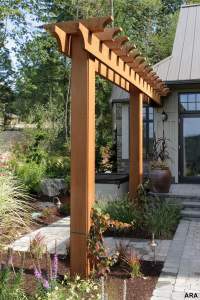Keep Your Cats Safe Outdoors and Protect Your Landscaping from Deer: A Virtually Invisible Fencing System Does Both
 (ARA) – Spring may be the ideal time to plant flowers, shrubs and work outdoors, but smart gardeners begin planning long before April showers bring May flowers. Actually, winter is the best time for strategic garden planning, as well as reviewing your landscape’s current flow and making decisions about what wonderful effects you’ll create in the garden next year.
(ARA) – Spring may be the ideal time to plant flowers, shrubs and work outdoors, but smart gardeners begin planning long before April showers bring May flowers. Actually, winter is the best time for strategic garden planning, as well as reviewing your landscape’s current flow and making decisions about what wonderful effects you’ll create in the garden next year.
As leaves fall and flowers disappear, the ‘bare bones’ of your landscape emerge, providing a canvas to easily imagine the perfect spot where an elegant trellis or another nice garden structure might go. These classic structures have been adding style, elegance and value to garden areas for centuries. Though you may not have recognized it at the time, there’s often a common reason why gardens incorporating these structures are more peaceful and serene than others.
Location is Key.
Remember, one of the greatest assets of any garden structure is its architectural appeal, so make sure the site and size you choose are appropriate for its surroundings. Consider attaching the structure to your home, using it to shelter a path between the main house and an outbuilding, or simply frame the view of another landscape feature.
Also, keep in mind the location from where the structure will be viewed. Will it be placed so it can be viewed from the deck, porch, kitchen or dining nook? Where will you enjoy it the most? These are all questions to consider when deciding on placement.
You may consider placing structures in the front yard as well, creating a unique look to the home’s exterior that enhances curb appeal and thus value. Remember, the exterior of your home is the face it presents to the world; it defines the mood and character of the home and reflects the desired image.
Dimensions 101.
Take special care when deciding the proportions of foundational posts, hand railings or overhead canopy of the structure. For instance, a set of 4-by-4 inch posts would be ideal with 2-by-6 inch overhead boards, but not vice versa. Also, make sure the posts are vertically straight and even in height, and ensure the overhead canopy boards are level and evenly spaced in parallel to each other. Attention to detail is essential here.
Embrace the Environment.
There’s often a key reason why some yards are more peaceful and serene than others. More than likely, the setting incorporates designs and materials embracing the natural environment, thus creating an outdoor haven that is a harmonious blend of architecture and nature.
In fact, through a simple coordination of all-natural materials and stylistically consistent additions gracefully creating a ‘balanced’ environment that becomes a component of the larger natural order almost becomes second nature.
Keep it Real
An easy approach to enhance and coordinate any landscape environment involves inserting structures made of all-natural materials. Western Red Cedar yard structures have been adding character, balance and elegance to outdoor spaces for years. These beautiful structures age beautifully and provide a synchronized blend of natural surroundings and architecture with all-natural architectural materials.
Western Red Cedar remains one of the most widely favored and versatile landscaping materials that easily lends itself to natural surroundings. Because of this, and its aesthetic appeal and physical properties, many people choose Western Red Cedar for outdoor applications.
With a long history of proven performance, cedar has been known for its exceptional beauty, versatility and longevity for centuries. Since the first residents of the Pacific Northwest referred to Western Red Cedar as the ‘Tree of Life,’ its legendary durability made cedar nature’s gift for building ocean-going canoes, post-and-beam houses, ceremonial dance masks and ancestral totem poles.
With centuries of proven performance, its no wonder today’s discerning homeowners, landscapers and architects around the world still ‘balance’ their projects with this remarkable material.
From a performance standpoint, cedar does not require treatment with toxic chemicals because it is naturally resistant to rot and insects, and its own natural preservatives help protect it in harsh weather. In other words, Western Red Cedar is ultimately more earth friendly and safer than other material alternatives.
Ready to turn your yard into an ‘Outdoor Sanctuary?’ With the right planning and all-natural materials, you’ll be able to create a relaxing outdoor paradise that will become a welcome respite from the hectic pace of everyday life. For more information on making your outdoor sanctuary a reality, go to www.realcedar.org or call (866) 778-9096.
Courtesy of ARA Content
